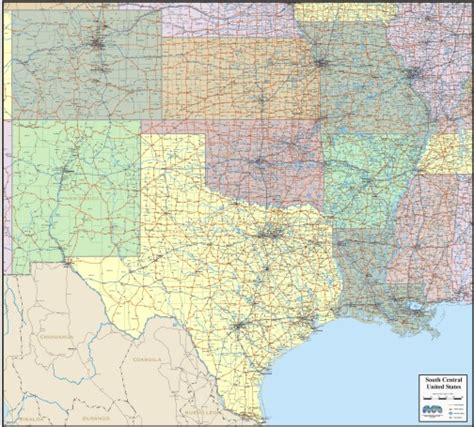Southcentral United States

The Southcentral United States, often referred to as the South Central region, encompasses a broad and diverse geographic area that includes parts of several states, primarily Oklahoma, Texas, Arkansas, and Louisiana. This region is characterized by its rich cultural heritage, varied landscapes, and a climate that ranges from humid subtropical to semi-arid. The Southcentral United States is not only a significant contributor to the country's agricultural output but also boasts vibrant cities, historic sites, and natural wonders that attract millions of visitors each year.
Natural Features and Climate

The Southcentral United States is marked by its vast plains, forests, and coastal areas along the Gulf of Mexico. The region’s climate is as varied as its landscapes, with hot summers and mild winters prevailing in most areas. Oklahoma, for example, experiences a humid continental climate with significant precipitation, while parts of Texas and the coastal regions of Louisiana exhibit more subtropical characteristics. The climate plays a crucial role in shaping the region’s ecosystems, from the pine forests of Arkansas to the desert landscapes of western Texas. Understanding these natural features and climate patterns is essential for managing the region’s resources, predicting weather events, and preserving its biodiversity.
Ecological Importance
The ecological importance of the Southcentral United States cannot be overstated. The region is home to numerous wildlife refuges, national forests, and protected areas that provide habitats for a wide range of flora and fauna. The Gulf Coast, in particular, is a critical stopover point for migratory birds and is known for its rich marine life. Efforts to conserve and restore habitats, such as wetlands and prairies, are ongoing, highlighting the region’s commitment to environmental stewardship. Moreover, the region’s agricultural productivity relies heavily on maintaining healthy ecosystems and conserving water resources, making sustainable practices a priority.
| State | Major Natural Features | Climate Type |
|---|---|---|
| Oklahoma | Plains, Ozark Plateau | Humid Continental |
| Texas | Deserts, Plains, Gulf Coast | Varied: Humid Subtropical to Semi-arid |
| Arkansas | Ouachita Mountains, Mississippi Alluvial Plain | Humid Subtropical |
| Louisiana | Coastal Wetlands, Mississippi River Delta | Humid Subtropical |

Economic and Cultural Significance

Beyond its natural beauty and ecological importance, the Southcentral United States is economically and culturally vibrant. The region is a significant producer of oil and natural gas, with Texas leading the nation in oil production. Agriculture is another major sector, with crops like cotton, soybeans, and rice being prominent. The cultural landscape is equally rich, with influences from indigenous peoples, European settlers, African Americans, and Latin Americans contributing to a unique cultural tapestry. Cities like New Orleans, Louisiana, and Austin, Texas, are known for their music scenes, culinary delights, and festivals, showcasing the region’s joie de vivre.
Historical Context
Understanding the historical context of the Southcentral United States is crucial for appreciating its current socio-economic and environmental challenges. The region has been shaped by numerous events, including the Civil War, the Civil Rights Movement, and significant economic shifts such as the oil boom and the decline of traditional manufacturing. These historical events have left lasting impacts on the region’s demographics, economy, and culture. For instance, the legacy of the Civil Rights Movement continues to influence social and political discourse, while the economic transitions have prompted innovative approaches to economic development and diversification.
Key Points
- The Southcentral United States is characterized by its diverse natural landscapes and climates.
- The region is ecologically significant, with numerous protected areas and a wide range of flora and fauna.
- Economically, the region is a major producer of oil and natural gas and has a significant agricultural sector.
- Culturally, the region is vibrant, with a unique blend of influences from various ethnic and national groups.
- Historical events have significantly shaped the region's current socio-economic and environmental landscape.
Challenges and Future Directions
Despite its many strengths, the Southcentral United States faces several challenges, including environmental degradation, economic inequality, and the impacts of climate change. Addressing these challenges will require innovative solutions, collaboration among stakeholders, and a commitment to sustainable development. Investing in renewable energy, enhancing educational opportunities, and promoting cultural exchange programs can contribute to a more resilient and equitable future for the region. Moreover, preserving the region’s natural beauty and cultural heritage for future generations is a responsibility that necessitates careful planning and management.
What are the primary economic sectors in the Southcentral United States?
+The primary economic sectors include oil and natural gas production, agriculture, and a growing service sector.
How does the region's cultural diversity contribute to its attractiveness?
+The cultural diversity of the Southcentral United States enriches its music, cuisine, festivals, and overall lifestyle, making it an appealing destination for tourists and a desirable place to live.
What are some of the environmental challenges facing the region?
+Environmental challenges include climate change, water conservation, and the preservation of natural habitats and biodiversity.
In conclusion, the Southcentral United States is a region of immense natural beauty, cultural richness, and economic significance. As the region continues to evolve, addressing its challenges while preserving its unique characteristics will be essential for ensuring a prosperous and sustainable future. By understanding the complex interplay between its natural features, economic activities, and cultural heritage, we can better appreciate the importance of this region and work towards its continued vitality and resilience.



